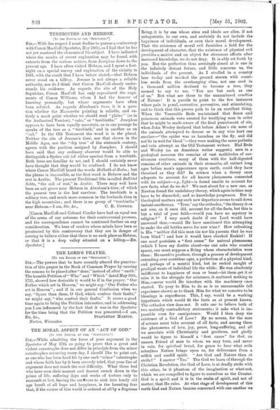TEREBINTHS AND HEBRON.
[To THE EDITOR OF THE "SPECTATOR."]
SIR,—With due respect I must decline to pursue a controversy with Canon MacColl (Spectator, May 24th), as I find that be has not yet mastered the elements of his subject. I have indicated where the results of recent exploration may be found, with extracts from the various notices, from Josephus down to the present age. I have often visited Hebron, and I spent a fort- night on a special survey and exploration of the vicinity in 1881, with the result that I have before stated,—that Hebron never stood on a hilltop. Jerome is not always a reliable authority, nor do I think that Canon MacColl clearly under- stands his evidence. As regards the site of the Holy Sepulchre, Canon MacColl has only reproduced the argu- ments of Canon Williams, whom I bad the honour of knowing personally, but whose arguments have often been refuted. As regards Abraham's trees, it is a ques- tion whether the Massoretic pointing is reliable, and en- tirely a moot point whether we should read " plains " (as in the Authorised Version), " oaks," or " terebinths." Josephus appears to have been equally uncertain, as in one passage he speaks of the tree as a " terebinth," and in another as an " oak." In the Old Testament the word is in the plural. Neither the site of Jerome's time, nor that shown in the Middle Ages, nor the " dry tree" of the sixteenth century, agrees with the position assigned by Josephus. I should have said that any ordinary observer would be able to distinguish a Syrian oak (of either species) from a terebinth. Both trees are familiar to rue, and I should certainly never have thought that they would be confused. I do not know where Canon MacColl heard the words Halkath-el-Butm ; but the phrase is impossible, as the first word is Hebrew and the rest is Arabic. The present Traditional Site is called Balliitet Sebta, "the oak of rest," in Arabic. There may well have been an oak grove near Hebron in Abraham's time, of which the present tree is the last survivor. The terebinth is a solitary tree, and much more common in the lowlands than in the high mountains ; and there is no group of " terebinths"
[Canon MacColl and Colonel Conder have had an equal use of the arena of our columns for their controversial prowess, and the correspondence cannot be continued further on any consideration. We hear of readers whose minds have been so prostrated by this controversy that they are in danger of coming to believe either that there is no such place as Hebron, or that it is a deep valley situated on a hilltop.—ED. Spectator.]










































 Previous page
Previous page